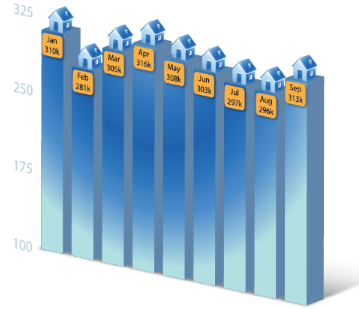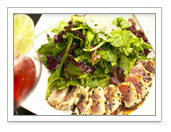| | IN THIS ISSUE... |
| |
| | | |
| | “Not what they seem?” - Things aren't always what they seem. Sometimes they're a pleasant surprise, and other times they have unintended consequences that we didn't consider. The articles below focus on just some of those situations, from good economic news…to foods that are misunderstood:
| |
| |
| | Good News Travels Fast |
| |
| | | |
| | Good news does indeed travel fast. That mantra proved especially true last month…but you may be surprised what that means.  First, there was some good news on the economic front in the U.S. last month. Retail Sales for September came in higher than expected and at the highest increase in seven months. In addition, growth in the U.S. economy picked up during the third quarter as the gross domestic product from July through September increased to nearly double the prior reading. This represents the fastest growth of 2011 and the largest increase in a year. While those news items are good for Stocks and the overall economy, the news isn't the only thing traveling fast. Money can also flow quickly out of Bonds and into Stocks - as investors move their money from the safety of Bonds into Stocks to try and take advantage of gains. And when that happens, Bonds and home loan rates typically take a turn for the worse. First, there was some good news on the economic front in the U.S. last month. Retail Sales for September came in higher than expected and at the highest increase in seven months. In addition, growth in the U.S. economy picked up during the third quarter as the gross domestic product from July through September increased to nearly double the prior reading. This represents the fastest growth of 2011 and the largest increase in a year. While those news items are good for Stocks and the overall economy, the news isn't the only thing traveling fast. Money can also flow quickly out of Bonds and into Stocks - as investors move their money from the safety of Bonds into Stocks to try and take advantage of gains. And when that happens, Bonds and home loan rates typically take a turn for the worse. The housing market also received some good news towards the end of last month. According to the U.S. Census Bureau and the Department of Housing and Urban Development, new home sales for September were up nearly 6% from the revised August rate. As you can see from this chart, the report came in just below the 2011 high set in April - and at the second highest level of the year. Home prices also received some positive news, as the Case-Shiller housing index marked the fifth consecutive month of gains with an overall 2% rise in August - and most of the cities surveyed saw their annual rates improve during the month. The improved annual rates show reason for optimism in the still struggling housing market. Housing Starts - or the initial phase of a new home being constructed - were also reported up last month as the report for September showed a 15% increase over the previous month. That increase represents the fastest growth pace in nearly a year and a half! Although the rise was led by multi-dwelling units, the report offers another glimmer of hope for the still sluggish housing market. Remember, however, that as the housing market and economy start to improve, home loan rates may start to move higher, especially if inflation rises (as discussed in the Q&A section at the bottom of this newsletter). For now, however, home loan rates remain near historic lows, so this is still a great time to purchase or refinance a home. If I can answer any questions at all for you, call or email me anytime. | |
| |
| | Foods That Fool You |
| |
| | | |
| |  The holiday season is filled with food - from large family dinners to extra sweets and baked treats. But if you're trying to watch what you eat over the next couple months, don't just focus on the obvious holiday extras. Instead, take a look at those everyday meals that aren't exactly what they appear to be - including foods that either misrepresent themselves or are somewhat misunderstood. The holiday season is filled with food - from large family dinners to extra sweets and baked treats. But if you're trying to watch what you eat over the next couple months, don't just focus on the obvious holiday extras. Instead, take a look at those everyday meals that aren't exactly what they appear to be - including foods that either misrepresent themselves or are somewhat misunderstood. Salads: There is no question that a salad is wonderful when it comes to delivering a delicious and nutritious meal or serving as a side. The question is, are you eating it this way? One doesn't have to go far to find a salad that includes ingredients like cheese, croutons, egg, fried chicken, etc. While all of these ingredients are delicious and can be enjoyed in moderation, they do nothing to help save on calories, carbs, or fat grams. One of the most popular salads in the USA is the Chicken Caesar. Did you know that the typical version of this salad has 700 calories with a whopping 46 grams of fat? Salads are at their nutritional best when they predominantly contain fresh, raw vegetables and lean protein. When adding any of the more highly caloric ingredients, do so in moderation, and try to add only one or two of them to your salad. Rice Cakes: Rice cakes are tricky! Although they are the poster child for all things healthy, they contain a large amount of high glycemic index carbohydrates, known to cause a rise in blood sugar levels. Elevated blood sugar levels have been shown to slow down the body's ability to burn fat. Crackers: It's a common perception that crackers are a good alternative to chips. Believe it or not, this isn't always the case. Many crackers contain more calories and fat than natural corn chips, not to mention hydrogenated oils and sugar. Fruit Juice: Regardless of whether it's bottled or freshly squeezed, fruit juice is high in both sugar and calories. While natural and fresh-squeezed juices do contain some positive nutrients, they are not the best choice for consuming in large quantities. Quite often, an 8-ounce glass of juice has nearly the same calories and sugar content as the same amount of soda. When consuming fruit juice, do so in moderation and stick to either fresh-squeezed or natural juices containing 100% juice with no added sugar. One way to limit your fruit juice consumption is to dilute it with spring water. Protein Bars: Protein bars are misleading. Many of these bars were designed with pro athletes in mind. When eating them as a between-meal snack, they can provide more protein than the average person needs, and more calories than the average person can burn off. For some bars, these amounts are so high they're more of a meal replacement than a snack. But here's the good news… Chili: This is a food that has received a bad rap - mainly because "restaurant chili" contains inordinate amounts of fat, sodium, and calories. But it doesn't have to be this way, as chili doesn't require large amounts of oil or meat to taste great. Lean ground turkey or chicken, or even various soy-based products can be used in place of beef and pork. The addition of various vegetables and legumes will add vitamins, minerals, and dietary fiber to your meal, thus making chili a nutrient-dense food. Nuts: Nuts should be eaten in moderation by anyone counting fat grams, but that doesn't mean they're an unhealthy food. Actually, it's quite the opposite. For starters, nuts are a fantastic source of low-carb protein. Due to their dietary fiber content, they also have the ability to curb hunger, making them a worthy between-meal snack. In the case of walnuts, they are also heart healthy as they contain Omega-3 fatty acids. Salsa: Truth be told, most salsas are low in calories and fat. An added benefit to eating any salsa with tomatoes as an ingredient is that it contains the nutrient lycopene, which is a powerful antioxidant. Aside from promoting overall heart health, the body converts lycopene into vitamin A, which aids both vision and healthy skin. Potatoes: Here's something you may not know. Potatoes are high in antioxidants. In fact, a Department of Agriculture study that looked at the antioxidant levels of over 100 different foods ranked the potato 17th highest overall in antioxidants. Red-skinned potatoes and sweet potatoes also have high levels of nutritious carotenoids. It's important to know that we are not recommending nor discouraging the consumption of any of these foods. As a matter of fact, a well-rounded diet that includes controlled portions and concentrates mostly on whole foods is the best way to go. But this also includes an occasional splurge. After all, variety is the spice of life - especially during the holiday season! | |
| |
| | Q&A: Inflation on the Mind? |
| |
| | | |
| | QUESTION:What's going on with inflation? ANSWER: Contrary to what the Fed has said about inflation moderating, year-over-year inflation is on the rise. In fact, the headline Producer Price Index (PPI) was reported up again last month. In addition, the Consumer Price Index (CPI) was reported last month at a year-over-year level of 3.9%, which is more than double from the 1.6% level in January. Remember, inflation is the archenemy of Bonds and home loan rates. The concept is very simple: If inflation rises, investors in Bonds demand a higher yield to offset the lost buying power inflation imposes on a fixed payment. And as home loan rates are tied to Mortgage Bonds, this would mean home loan rates move higher. If you have any questions about how inflation and economic news might impact the home loan rate you can get, please call or email today. It will only take a few moments to discuss what's going on based on your unique goals and financial situation. | |
| |
| |
| | | |
| | Mortgage Success Source, LLC is the copyright owner or licensee of the content and/or information in this email, unless otherwise indicated. Mortgage Success Source, LLC does not grant to the recipient or distributor a license to any content, features or materials in this email. You may not distribute, download, or save a copy of any of the content except as otherwise provided in our Terms and Conditions of Membership, for any purpose.  | |
No comments:
Post a Comment